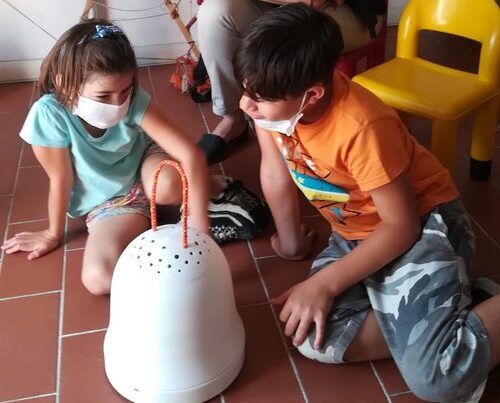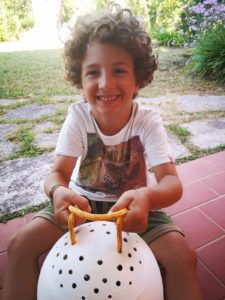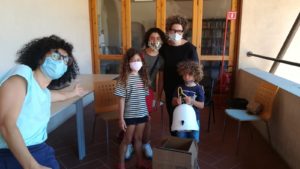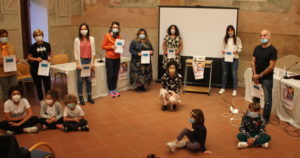Blog
Remote intergenerational learning: an experiment in Italy evaluated by TOY

“My child discovered the pleasure of imagination and curiosity: imagining what was going to be read to her and being curious about who would read it to her” says P., mother of Z (5 years old).
This is the opinion of a mother whose child participated in the pilot of the intergenerational Storytellers Project in Empoli, Italy. Words like mystery, anticipation, curiosity, and even magic often came up in the accounts of the parents when they thought about their children’s emotions during this experience.
The Storytellers project was piloted between February and September 2020 in a public library and involved 5 families with children between 3 and 11 years old, and 8 adult readers. The pilot began with four workshop sessions for library staff and senior readers about benefits and approaches in IGL involving young children and older adults, interactive reading and children’s literature. In the following months, the children and readers took part in 23 remote reading sessions.

But let’s start from the basics: what is the Storytellers project? And how is TOY involved?
The Storytellers Project is a library service that connects a community of adult readers (the Storytellers) to young children and their families for remote reading aloud sessions. It was developed and initiated in 2017 by Laura Boffi, an interaction & service designer and researcher based in Italy. The aim of the project is to foster intergenerational relationships and promote active aging and playful learning. How is this achieved? Children use the Storybell robot at home to connect with readers willing to read. The Storybell robot transmits their reading live, allowing children and readers to speak and interact as on the phone. Most of the readers are older adults living in the same city as the children.
Laura Boffi, the creator of the Storytellers Project, first made contact with the TOY Programme in 2017, when she was developing the first concept of the project. In 2019, Laura Boffi conducted the feasibility study for The Storytellers Project and interviewed us, Margaret Kernan and Giulia Cortellesi, the two co-coordinators of the TOY Programme. Following this, we were invited to participate in its prototyping and piloting. Our role was to provide training in IGL pedagogy and to design and conduct the evaluation of the Storyteller Project pilot.
Our initial plans for the evaluation included face-to-face interviews and focus groups with parents, children and adult readers, but then the COVID-19 pandemic arrived, and we had to rethink our plans and organize everything remotely. This was a pity, but on the other hand, this extraordinary situation highlighted the potential of the Storytellers project, which was able to remotely connect and facilitate relationships between non biologically related children and adults in times of social distancing.
But, if we were to summarise what we learned, this is what we would say:
Children, parents and readers were all enthusiastic about the experience and expressed their wish to participate in the Storytellers project beyond the pilot. This is a great result, considering that the Storybell robots were not fully functional in this phase and all participants had to cope with some frustration because of the poor connection and bad sound quality at times.

Adult readers felt valued, useful and recognized for their role as readers and older adults. They also felt active, able to teach children to trust other people, and in particular older adults.
“Participating in this project makes me feel good. I feel new emotions: when I see the phone ringing and I read for example ‘Storybell number 3’, I say ‘Oh gosh, the Storybell!’. Then I stop whatever I am doing and pick up the call immediately. One time I left my dinner on the table” says A., 54 years old.
The Storybell was the main attraction for children. They had a new, interactive, almost magical toy at home, which could connect them to a stranger reader and allow them to listen to a story and engage in playful conversations.
“The Storybell has become a symbol in our home. It is like a ‘piazza’ (square), where we gather around, meet each other and listen, very much like a church bell tower in a village” says M., mother of T. (6 years old).
To read more about our findings see the evaluation report, which you can download here.
In conclusion we feel the Storytellers Project has great potential and could still be developed in many directions. Based on the insights gained during the evaluation, we would recommend combining remote readings with face-to-face meetings, when possible. Another recommendation is to build a broader network of services (such as: schools, old people’s homes, community centres, playgroups, etc.) to connect children and readers. In this way The Storytellers Project could achieve another important goal of intergenerational learning: social cohesion.

Luckily, it was possible to organize a face-to-face final event at the end of the pilot in September, before the second wave of COVID-19 hit Italy, and finally children and readers were able meet each other in person!
To find out more about the Storytellers Project you can contact Laura Boffi, boffilaura@gmail.com